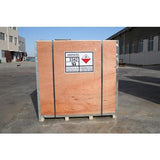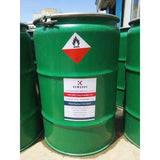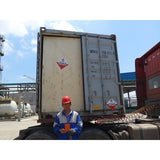Potassium Amyl Xanthate (PAX) 90%min
Potassium amyl xanthate is one of the most powerful flotation collector widely used in mineral processing. It is relatively unselective and has a strong tendency to float iron sulfides unless depressants are used. It is used as a good mining reagent for the flotation treatment of all sulfide minerals, Cu/Ni sulfide ore, zinc ores, as well as gold associated with pyrite( gold containing iron sulfides). This mining chemical tends to recover all sulfides if circuit pH is maintained between pH 7 and pH 9.
WHAT KEMCORE PROVIDES AS A PARTNER?
Reliable Supply
KEMCORE is always prepared to fulfill orders as they're placed and deliver the product customers need.
Commitment to Safety
KEMCORE has been safely and responsibly distributing Potassium Amyl Xanthate for decades and continues to make advancements through improved packaging options, on-site unloading services, and comprehensive training for our customers.
Dedicated Support
Whether it’s assisting with Potassium Amyl Xanthate handling or regulatory needs like licensing, permitting, and compliance monitoring, support is available.
COUNTRIES OF ORIGIN
- China
- Serbia
- South Africa
- India
SYNONYMS
Potassium Amyl Xanthate (PAX) / Flottec PAX / XANTATO AMILICO DE POTASIO/ Flomin C3505 / AERO 350
CAS Number: 2720-73-2
Molecular Formula: C6H11KOS2
PRODUCTION OF XANTHATES:
RAW MATERIALS: are Carbon Disulfide, Caustic Soda (Sodium Hydroxide), or Potash (Potassium Hydroxide) and determined alcohol, which provides it with collecting properties in flotation processes of metallic and polymetallic minerals.
WHAT IS THE QUALITY OF YOUR XANTHATE?
The production of pure xanthates requires pure raw materials and then the reaction must also be driven to completion. This requires sophisticated process design and control of the manufacturing process which, in turn, influences the price and metallurgical efficiency of the product.
DOWNLOAD OUR CASE STUDY TO AVOID BUYING SUB-STANDARD XANTHATE!
XANTHATE APPLICATION:
Potassium Amyl Xanthate, strong, unselective collector , with 5 carbon molecules in its chain, is strong, unselective, and is ideal for sulfide gold operations where all sulfide minerals need to be recovered.
It can be applied for the flotation of all types of sulfide minerals in combination with weaker xanthates.
Xanthates in mining
Xanthates have been the workhorse of sulfide mineral flotation since the 1920s (Harris 1989), and they represent the largest volume of any sulfide mineral collector. Xanthate collectors are salts consisting of a non-polar hydrocarbon group, which provides the hydrophobicity to a sulfide mineral, pointing outward from the mineral to the solution, and a polar group that adsorbs onto the sulfide mineral surface.
Xanthates |
Relative Strength |
Typical Plant Concentration % |
WEAK |
10-20 |
|
|
↓
STRONG |
10.20 |
|
10-20 |
||
15-25 |
All Xanthates are water-soluble and are usually fed in as aqueous solutions in a 5 to 20% strength.
These reagents are widely used for all sulfide minerals, with a high tendency to float iron sulfide, except when using depressors. They cannot be used in highly acidic circuits, as they tend to decompose.
Kemcore carries common Xanthate products equivalent or similar to:
Potassium Ethyl Xanthate (PEX) |
Aero 303 |
Potassium Amyl Xanthate (PAX) |
Flottec PAX/Flomin C3505/AERO 350 |
Sodium Ethyl Xanthate (SEX) |
Flottec SEX/FloMin C 3200/AERO 325 |
Sodium Isobutyl Xanthate (SIBX) |
Flottec SIBX/FloMin C3430/AERO 317 |
Sodium Isopropyl Xanthate (SIPX) |
Flottec SIPX/Flomin C3330/AERO 343 |
Sodium n-butyl Xanthate SNBX |
FloMin C 3410 |
Sodium Amyl Xanthate |
Our range of modifiers, collectors, and frothers are produced in fully integrated world-class facilities in China and Kemcore guarantees a continuous supply to our customers worldwide.
Advantages of Xanthate.
- The least expensive sulfide mineral collector-Inexpensive compared to Specialty Collectors
- Easy to manufacture and available in solid pellet form for easy handling
- Dosage: in-plant environment, they’re fed at active concentrations of 5% or less in water.
- Very good at recovering in an unselective manner bulk sulfide minerals, including sulfides.
- Can be used with lime to give a pH operating range of 9-12.
- Can be used as a sole collector in a sulfide mineral plant.
Plant Operation Tips:
- The sequence of addition of modifiers, collectors, and frothers is of great importance, especially when sulphidising agents and other activators and depressants are involved.
- Flotation is a process that relies heavily on surface chemistry, by adding all of the collectors to the conditioner, a thick, scummy and uncontrollable froth is obtained which yields a low and unmarketable grade concentrate with entrained insoluble minerals. Therefore careful consideration should be taken when selecting reagent-dosing points in the plant so that recovery and grade are optimized.
-When trialing additional or different collectors maintain a visual inspection history of the froth and concentrate in each circuit.
- Data from each shift should be collected over the duration of the trial so that shift recoveries and grades can be determined and to ascertain whether the trial collector is better or worse than the incumbent collector.
Synonyms: Glacial acetic acid; Acetic acid solution; acetic acid 50%; acetic acid, of a concentration of more than 10 per cent, by weight, of acetic acid; Acetic Acid Glacial BP; Natural Acetic Acid; Acetic acid (36%); Acetic acid, food grade; Acetic Acid Glacial; GAA; Acetic Acid, Glacial
It is a colourless liquid that when undiluted is also called glacial acetic acid. It has a distinctive sour taste and pungent smell.
Acetic acid uses: Additive in industrial explosives in Mining.
Other uses include use of acetic acid in the production of vinyl acetate monomer, acetic anhydride and ester production.
Chemical gassing agents -In the case of emulsion explosives, using Acetic acid can accelerate the gassing process. The chemically gassed emulsions may take 40 – 50 minutes for completion of gassing within the blast holes, particularly when the emulsion is colder.
In cases where acetic acid is used, it is added to the emulsion prior to gassing, the desired amount of acid is mixed in the emulsion, before adding the gasser.
A gassing solution comprising sodium nitrite in water together with the selected enol compound and acetic acid is introduced into the emulsion explosive at the blast hole by entraining the gassing solution into a stream of the emulsion explosive using pumps.
The solution pH is an important parameter in the gassing of emulsion explosives due to the high cost associated with acid addition therefore a pH value should preferably be maintained at 4.1 or below.
|
Identifiers |
|
|
Abbreviations |
AcOH |
|
CAS number |
64-19-7 |
|
PubChem |
176 |
|
ChemSpider |
171 |
|
UNII |
Q40Q9N063P |
|
EC number |
200-580-7 |
|
UN number |
2789 |
|
Properties |
|
|
Molecular formula |
C2H4O2 |
|
Molar mass |
60.05 g mol |
|
Appearance |
Colourless liquid |
|
Odor |
Pungent/Vinegar-like |
|
Density |
1.049 g cm |
|
Melting point |
16 to 17 °C; 61 to 62 °F; 289 to 290 K |
|
Boiling point |
118 to 119 °C; 244 to 246 °F; 391 to 392 K |
|
Solubility inwater |
Miscible |
|
Acidity (pKa) |
4.76 |
|
Basicity (pKb) |
9.198 (basicity of acetate ion) |
|
Refractive index(nD) |
1.371 |
|
Viscosity |
1.22 mPa s |
|
Dipole moment |
1.74 D |
1- TRANSPORT INFORMATION
- Transport-UN 2789
- Hazard Class No. : 8
- Packing Group: II
- H.S. Code: 2915211900
2- STORAGE & HANDLING
- Stable at room temperature in closed containers under normal STORAGE & HANDLING and handling conditions. Refer to SDS sheet
3- PACKING
|
Packing type |
Tons/FCL |
|
IBC Drums |
18tons/FCL |
|
30kg Drums |
21tons/FCL |
|
200Kg drums |
16tons/FCL |
4.Environmental impact
- Acetic acid biodegrades readily under both aerobic and anaerobic conditions.
- Acetic acid does not absorb light with wavelengths >290 nm(4), and is not expected to be susceptible to direct photolysis by sunlight(SRC).
- Incase of spillage neutralize spill with soda ash or lime.
5. Download our Acetic acid msds for more handling information.
















